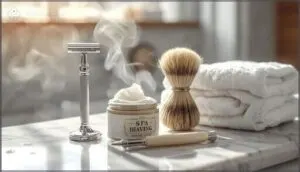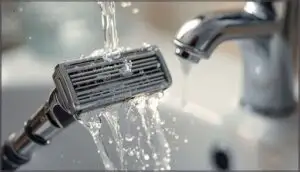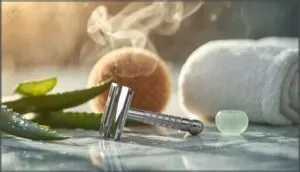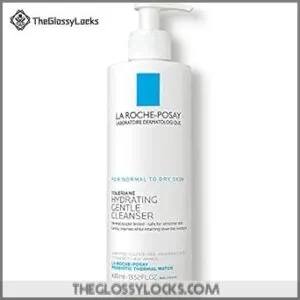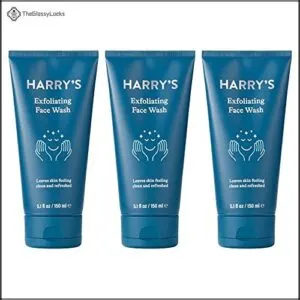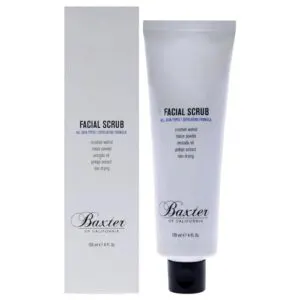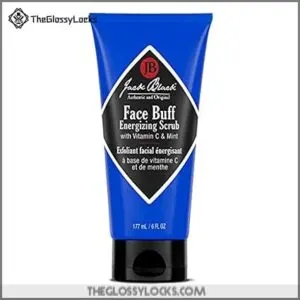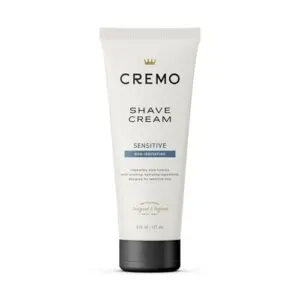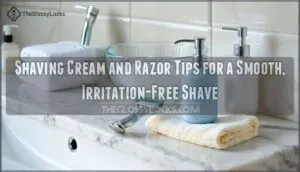This site is supported by our readers. We may earn a commission, at no cost to you, if you purchase through links.
Most people pick up a razor and hope for the best, which explains why razor burn and ingrown hairs are so common. The truth is, proper shaving isn’t about expensive products or fancy equipment—it’s about technique. Your skin takes a beating every time you shave, and doing it wrong can lead to irritation, cuts, and bumps that stick around for days.
The difference between a smooth, comfortable shave and a painful one comes down to understanding a few key principles. When you cleanse properly, use the right tools, and follow the grain of your hair, you’ll notice fewer problems and better results.
Learning how to shave properly at home means treating your skin with care before, during, and after each session, so you can get that clean look without the aftermath.
Table Of Contents
- Key Takeaways
- Pre-Shave Preparation Tips at Home
- Selecting The Right Shaving Tools
- Step-by-Step Shaving Techniques
- Top 5 Products for a Smooth Shave
- Frequently Asked Questions (FAQs)
- How do I get a close shave?
- How to get a clean shave?
- How to make a good shave?
- How do you shave your torso?
- How do you shave without irritating your skin?
- How do you shave a head to toe?
- How often should I replace my razor blade?
- Can I shave immediately after a workout?
- Whats the best water temperature for rinsing?
- Should I shave before or after showering?
- Conclusion
Key Takeaways
- Proper shaving technique matters more than expensive products—prep your skin with warm water and exfoliation, then shave with the grain using a sharp blade to avoid irritation and ingrown hairs.
- The key to a smooth shave is softening your hair with warm water for 60–90 seconds before you start, which reduces cutting force by up to 65% and makes your razor glide easier.
- Replace your razor blade every 5–7 shaves or when you notice tugging and irritation, because dull blades cause more skin damage than any other shaving mistake.
- Different body areas need different approaches—facial hair requires following the grain strictly, while legs can handle multiple passes, but sensitive areas always demand gentle strokes and extra care.
Pre-Shave Preparation Tips at Home
Getting a clean, smooth shave starts before the razor ever touches your skin. The right prep work makes all the difference between irritation and comfort.
Here’s what you need to do to set yourself up for success.
Cleansing and Exfoliating The Skin
Before you even pick up a razor, skin preparation makes all the difference. Start by cleansing with a gentle product suited to your skin type—this removes dirt and oils that can clog your blade.
Then exfoliate to lift dead skin cells and prevent razor burn. If you have oily skin, exfoliate 2-3 times weekly. Sensitive skin? Once every two weeks works best.
Shaving against the grain increases the likelihood of developing razor burn.
Softening Hair With Warm Water or Towel
Once your skin is clean, warm water becomes your best friend. Soak your face for 60–90 seconds or apply a warm towel—water temperature between 100–110°F softens hair and improves razor glide. This simple step hydrates hair shafts, reducing cutting force by up to 65%. Understanding the benefits of hot towel treatments can greatly improve your shaving experience.
Here’s what warm water preparation does for you:
- Softens stubble and increases hair pliability for smoother shaving
- Boosts circulation benefits and gets skin ready for blade contact
- Minimizes irritation and razor burn through better hair hydration
Trimming Longer Hair Before Shaving
After softening, grab your beard trimmer if your facial hair is longer than 5 mm. Trimming first reduces blade clogging by 27% and cuts down nicks by 15%. Use a length guard to get hair under that 5 mm sweet spot—it makes a real difference.
Professional barbers know trimming prevents 19% more ingrown hairs and boosts comfort by 23%. Clean your trimmer after use—hygiene practices matter for skin health impact.
| Trimmer Blade Types | Length Guard Usage | Trimming Frequency |
|---|---|---|
| Japanese steel blades | 6mm and 10mm guards | Every 4–6 weeks |
| Zero gap precision | Adjustable settings | Before each shave (if over 5mm) |
| Comfort edge wide | Pre-shave reduction | As needed for bushiness |
Applying Shaving Cream or Gel Properly
Once your beard’s trimmed and ready, shift focus to pre-application preparation. Massage shaving cream or gel onto damp, clean skin for better coverage—never rush this step.
Using a shaving brush? Circular motions build a thicker lather, help lift hairs, and spread product evenly. Steer clear of aggressive rubbing; that’s the fast lane to irritation and common application errors.
Selecting The Right Shaving Tools
Choosing the right shaving tools is the key to a smooth and comfortable shave. From finding the best razor for your skin to picking the right creams and gels, every detail matters.
Here’s what you’ll want to think about before you start.
Types of Razors (Cartridge, Safety, Electric)
Ever wondered how the right razor shapes your shave? For a true Razor Comparison, know this: cartridge razors offer speed and safety, safety razors use a single steel blade for control, and electric shavers turn convenience up a notch. Each stands out for Blade Material, User Skill level, or Market Trends. Consider the Environmental Impact, too.
- Cartridge razors: multi-blade, convenient
- Safety razors: classic, recyclable
- Electric shavers: fast, mess-free
Choosing The Best Razor for Your Skin and Hair Type
Picking the right razor isn’t just about preference—it’s about matching your skin type and hair texture. If you deal with Sensitive Skin, look for razors designed to avoid irritation and consider fewer blades. Coarse Hair calls for sharp blades and a thoughtful Razor Design.
Don’t forget to check Replacement Frequency; dull blades mean more tug and less comfort every shave.
Essential Shaving Aids (Creams, Gels, Brushes)
Quality makes all the difference. Shaving cream holds the largest Cream Market Share for a reason—it softens, cushions, and keeps skin moisture in check.
Shaving gels go further, offering Gel Lubrication Benefits and Sensory Cooling Effects, especially for sensitive skin.
Add a shave brush and you’ll boost Brush Exfoliation Impact, better product coverage, and comfort. Adoption Statistics show these shaving products are rising for good reason.
Razor Blade Maintenance and Replacement
A sharp blade is your best friend. Cleaning razor blades after each use, using careful strokes—not banging them on the sink—preserves blade sharpness. Storage best practices are simple: dry the blade and store it upright.
Signs like tugging or post-shave irritation mean it’s time for replacement. Good razor blade maintenance saves your skin, your wallet, and the planet.
Step-by-Step Shaving Techniques
Getting a clean shave at home starts with using the right technique. Here’s what you need to know to make each step count.
Let’s break down the key parts of the shaving process.
Shaving With The Grain Vs. Against The Grain
Think of shaving technique like steering a boat—shave with the grain, following your hair growth, for maximum Irritation Reduction and lower risk of Ingrown Hairs. Shaving against the grain brings Shave Closeness, but at the cost of more redness and Follicle Effects.
Most Dermatologist Recommendations guide you to go with the grain, especially if your skin’s easily upset.
Techniques for Face, Legs, Armpits, and Pubic Area
Ever wonder why each part of your body needs a different shaving approach? Facial hair growth can be stubborn; always shave with the grain for less irritation.
For legs, soften skin first to reduce sensitivity. Armpit shaving direction matters—follow hair growth there too.
For pubic hair removal, use gentle strokes and follow proven shaving safety tips. Precision protects your skin.
Rinsing and Caring for The Razor During Shaving
Fresh blade gliding isn’t luck—it’s blade hygiene and razor care tips in play. Warm water loosens sticky lather, stopping buildup before it starts. With each pass, rinse that cartridge razor often and lightly tap—no aggressive wiping. After shaving, dry gently and store in a dry spot. Following this routine pays off with razor longevity and cleaner, smoother shaves.
| Water Temperature | Warm, not hot |
|---|---|
| Rinsing Frequency | After every swipe |
| Drying Methods | Pat, never rub |
| Blade Hygiene | Avoid leaving wet |
Preventing Razor Burn and Ingrown Hairs
Preventing razor burn and ingrown hairs comes down to technique. Exfoliation benefits show up when you remove dead cells before shaving—it clears the way for your blade. Shaving direction matters: go with the grain, not against it.
Blade sharpness can’t be ignored either. Dull edges tug and irritate.
Post-shave care with aloe or moisturizer calms skin sensitivity fast.
Top 5 Products for a Smooth Shave
The right products make all the difference between a quick shave and a smooth, irritation-free experience. You don’t need a bathroom full of bottles, just a few reliable tools that prep your skin and protect it during the process.
Here are five standout products that deliver consistent results without the guesswork.
1. La Roche-Posay Gentle Face Cleanser
For facial cleansing before you shave, this gentle cleanser stands out. It’s formulated with ceramide-3 and niacinamide to support barrier restoration while preparing skin for shaving. The face wash won’t irritate facial skin—it’s dermatologist tested specifically for sensitive skin and won’t clog pores.
You’ll appreciate the ingredient benefits: thermal spring water soothes, glycerin hydrates, and it’s free from soap, oil, and fragrance.
Plus, the sustainable packaging refill uses 73% less plastic. It’s a smart choice for daily use.
2. Harry’s Exfoliating Face Wash For Men
Harry’s Exfoliating Face Wash brings volcanic rock and essential oils together in one bottle. You’ll get that cooling tingle from peppermint and eucalyptus—it’s part of what makes this face wash stand out during facial cleansing.
The fine exfoliating particles lift away dead skin cells without harsh scrubbing, which helps soften your beard before shaving. User feedback shows it works well for daily exfoliation, though some guys with sensitive skin notice dryness afterward.
At under $7, it’s an affordable option that’s earned its market position in men’s grooming.
3. Baxter of California Exfoliating Face Scrub
Baxter of California’s Exfoliating Face Scrub combines walnut shell powder with avocado oil for a preshave routine that’s been sharpening shaves since 1965.
This scrub’s ingredients blend works into your facial cleansing without stripping moisture—something your sensitive skin will appreciate. You’ll massage it onto damp facial skin in circular motions, exfoliating the skin to lift hairs and clear pores before your razor glides through.
The brand reputation speaks for itself among barbers. At $22 for 4 ounces, it’s pricier than your average face wash, but the non-drying formula shows results twice weekly.
4. Jack Black Energizing Face Scrub
Jack Black’s Energizing Face Scrub packs bamboo powder and vitamin C into a preshave preparation that’ll wake up your facial skin before the razor touches down. You’ll exfoliate two to three times weekly with this face wash, working a dime-sized dollop across damp skin in gentle circles.
The mint-infused formula lifts dead cells and clears pores without the harsh drag some scrubs deliver. Market reception confirms what barbers already know—its exfoliation power prevents ingrown hairs while minimizing skin irritation.
At $30, it’s worth the investment for consistent results.
5. Cremo Sensitive Ultra Slick Shave Cream
Cremo Sensitive Ultra Slick Shave Cream delivers barber-grade quality without overwhelming sensitive skin. The ultra-slick formula stays translucent, allowing you to track your blade path and reduce nicks while your razor glides smoothly.
You’ll apply an almond-sized amount to damp skin—that’s all you need. With essential oils instead of synthetic fragrance, this shaving cream soothes irritation during every pass.
Consumer ratings hold steady at 4.3 stars, and most users report the concentrated formula lasts about 90 days. At $7.97, it’s solid value for consistent shaving product application.
Frequently Asked Questions (FAQs)
How do I get a close shave?
To get a close shave, start with proper shave prep using pre-shave oil. Keep blade sharpness in check, maintain the right shaving angle, apply skin tension, and use multiple passes with shaving techniques that follow the grain.
How to get a clean shave?
About 75% of people who master clean-shave techniques start by shaving with the grain, then carefully against it.
You’ll need sharp blades, proper shaving angle, and gentle skin tension for smooth results.
How to make a good shave?
A good shave starts with proper skin hydration and hair softening using warm water.
Apply quality shaving cream, use a sharp blade with light pressure, follow the grain, and finish with soothing aftershave.
How do you shave your torso?
Shave your torso with the grain using a sharp razor and plenty of shaving cream. Trim longer body hair first, then use short strokes to prevent irritation and ingrown hairs on sensitive skin.
How do you shave without irritating your skin?
Ironically, most irritation comes from trying too hard.
Use a sharp blade, shave with the grain, apply minimal pressure, and moisturize afterward.
Your skin will thank you for the gentler approach.
How do you shave a head to toe?
Full body shaving requires you to trim longer hair first with clippers, then wet shave with the grain using light pressure.
Different body parts need adjusted techniques—legs tolerate multiple passes while sensitive areas demand gentler strokes.
How often should I replace my razor blade?
Like a worn tool losing its edge, your razor blade needs replacing every 5 to 7 shaves.
Watch for tugging, irritation, or visible rust—these dullness indicators mean it’s time for a new razor.
Can I shave immediately after a workout?
It’s best to wait 10–15 minutes after your workout to let your skin cool down and reduce irritation. Cleanse thoroughly first to remove sweat and bacteria before shaving.
Whats the best water temperature for rinsing?
Lukewarm water works best for rinsing your razor during a shave. It balances blade sharpness and skin sensitivity while softening hair effectively.
Cold water afterward calms skin irritation and tightens pores without compromising razor material.
Should I shave before or after showering?
Shave after showering. Warm water softens hair by 60%, opens pores, and cuts razor burn by up to 40%.
Your skin is cleaner, blades glide easier, and you’ll get fewer nicks with less irritation overall.
Conclusion
Think shaving is just dragging a blade across your skin? That theory falls apart the moment you feel razor burn. The truth is, how to shave properly at home depends on respecting your skin’s direction, preparing it right, and using sharp tools with care.
Master these fundamentals, and you’ll trade irritation for smoothness every time. Your face, legs, or anywhere else you shave will thank you for treating the process like the skill it actually is.
- https://providers.clevelandclinic.org/provider/shilpi-khetarpal/4268654
- https://my.clevelandclinic.org/health/diseases/17722-ingrown-hair
- https://thebeardclub.com/blogs/beard-culture/should-i-wash-my-face-before-or-after-shaving
- https://soldejaneiro.com/blogs/body-care/do-you-shave-or-exfoliate-first-for-the-best-results
- https://www.myfreebird.com/blogs/health/exfoliate-before-or-after-shaving




